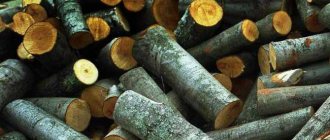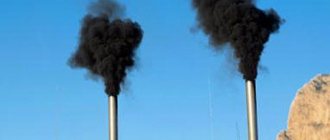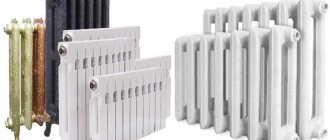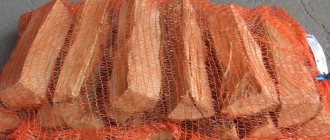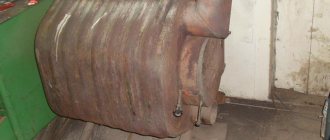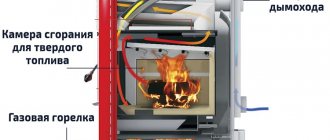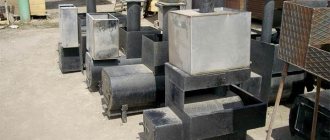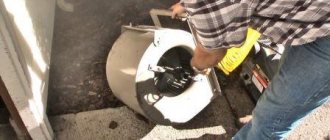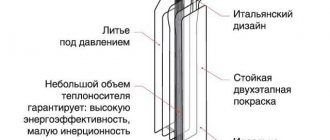If the house uses a wood-burning stove as the main or backup heat source, and in addition to it, the household has a bathhouse, barbecue or smokehouse, the owners have to prepare fuel every year. Moreover, you need to do this wisely, choosing which firewood is best for the stove, and which to stock up on for the fireplace or frying meat on the fire. In this matter, everything is important: the type of wood, humidity, and even the “age” of the firewood. Read the article on how to choose them.
Shooting embers from the open mouth of a fireplace is fraught with fire Source kamin-top.ru
- For a home stove, it burns long and intensely, with minimal ash formation and high heat transfer, allowing you to add fuel and clean the firebox as little as possible.
- It’s also clear what kind of wood is best to heat a sauna - it burns quickly and gives a lot of heat.
The general requirement for all firewood is good combustibility and high heat transfer. These qualities largely depend not only on the type of wood, but also on humidity. Even the most “correct” wood will burn poorly, emitting a lot of smoke and leaving unburnt coals if it is not dried.
Firewood from recently cut trees has the highest humidity, especially if it was harvested during the period of active movement of sap - in spring or summer. The drying speed of different breeds is also different: some require several months, others up to two years, provided they are stored correctly.
It is better to buy firewood cut in winter and store it in a woodpile Source mirlandshaft.ru
Advice! It is easy to determine the degree of moisture in firewood: dry logs make a ringing sound when they hit each other.
Another important selection criterion concerns the ability of firewood to release resinous substances and soot when burning, which clog the chimney. Alder and aspen firewood have the lowest degree of soot formation, while coniferous firewood ranks last in this parameter. For a bathhouse with a straight chimney, this is not very critical - the channel without bends is easy to clean. But for a home brick stove with an elbow chimney, its overgrowing with soot and soot is fraught with loss of draft and related problems.
See also: Catalog of companies that specialize in the design and installation of fireplaces and stoves
Choosing firewood according to the characteristics of the breed
Firewood belongs to the category of goods that are not transported from afar, but are content with those that are harvested in nearby areas. Otherwise, transportation costs more than the fuel itself. But if you have a choice, you should think about which firewood is better, analyze the prices and buy high-quality fuel.
Chopped firewood is more expensive Source bizorg.su
Whenever possible, preference is given to hard hardwoods with a dense wood structure that burn hot and long. Coniferous firewood is also used, but, given its resinous nature and the formation of soot, they try to do this not all the time.
We invite you to learn more about the different types of firewood and their efficiency for heating.
Oak
In all respects, oak firewood is considered the best for stove heating, but also the most expensive. Hard and dense oak wood:
- burns for a very long time;
- gives off more heat than all other breeds;
- due to slow and long burning it is economically consumed;
- emits a pleasant forest aroma and releases beneficial fumes.
These qualities are most characteristic of firewood from middle-aged trees. Below you can see which firewood is the hottest: the calorific value table for the main types puts oak in first place.
Heat transfer depends on the moisture content of the wood Source baza-drov.com.ua
Beech, ash, maple
Wood with properties similar to oak are ash, maple, yew, beech, hornbeam and other hardwoods. They are also difficult to ignite, but burn for a long time and release a large amount of heat.
But firewood from maple, beech and hornbeam is almost never found on sale, since these species are valuable and are not cheap; using them for heating a house is too wasteful. Firewood made from yew, acacia and ash is more affordable in price and availability, but it is better to use it sparingly - in severe frosts or for gatherings by the fireplace.
Typically, only waste of valuable species from woodworking or furniture production is used for firewood Source ytimg.com
Alternative option
In city apartments, unfortunately, we cannot install a full-fledged fireplace, either open or closed, since it is technically almost impossible to do this. At the same time, we can easily install a bio-fireplace that runs on alternative fuel.
To create a full-fledged ambiance, you should use ceramic firewood for a biofireplace, which, along with other decorative accessories, are sold in appropriate stores. Made from ceramics and properly painted, decorative firewood, logs or coals will perfectly complement the live fire of a bio-fireplace, and you will receive a full-fledged aura of comfort, coziness and warmth.
We hope that after reading this material, you have no questions about what kind of firewood is best to use to light a fireplace. Use dry and high-quality wood to get maximum results.
Video description
How to clean a chimney by burning aspen or sedge firewood, watch the video:
Linden
Like birch, linden firewood is stored no longer than two to three years, after which it loses quality. However, they are highly valued as fuel for sauna stoves, as they are capable of burning very intensely and heating it in a short time.
When burned, linden produces aromatic smoke and releases phytoncides with medicinal properties that promote wound healing and alleviate the symptoms of pulmonary diseases.
Linden is an excellent fuel for a bath Source element-house.ru
Linden firewood is not suitable for constant heating of a house in winter due to its ability to burn out too quickly.
Can you heat the fireplace with briquettes?
Having satisfied the drinking of the companions, the firewood growers began to produce European firewood from previously refined vugill, peat and thyrsi. The stench burns longer, the fragments contain a minimum amount of water (up to 11%), as can be seen during the process of fermentation. Other features:
- Heat generation is 30-50% greater, lower with the use of primary firewood;
- the need to refill the cavity for a stable fire;
- frying (if you choose peat briquettes, you will first need to light a little firewood).
Additional advantages are the availability of sparks, which excludes occasional activities, as well as the ease of saving. On the other hand, stench does not provide such a beloved rich crackling sound and does not provide an aesthetic effect.
How can you light a fireplace with vugillas?
If the fireplace has indicated that the fireplace is suitable for your fireplace, then you can use it, but with certain nuances:
- the grate bars were torn from the chavun;
- to achieve maximum heat output, it is necessary to check the thickness of the fire;
- The grate must be increased in height to ensure sufficient air flow.
How to prepare and store firewood
You can buy oak, birch or poplar for firewood in the form of whole logs or already split into logs. There is another option - to purchase waste in the form of branches, twigs, bark, but it may only be of interest to summer residents who come to relax by the fire.
It is more profitable to purchase unchopped firewood, but if there is no one to chop it, preference should be given to the seller who carefully and tightly placed the logs in the back of the car or woodpile. The fact is that the unit of measurement for firewood when selling is a cubic meter. If they are folded carelessly, there will be a lot of empty spaces between them, and you will literally pay some of the money for air.
It is impossible to determine the true volume of piled firewood. Source drovenik.ru
Split firewood is stored for storage, since logs take longer to dry, and birch logs can generally rot. The woodpile is placed under a canopy or in a special woodshed with ventilated walls. It is also possible in the open air, but by making a flooring above the ground and covering or laying the top row so that precipitation does not seep inside.
What should you pay attention to when buying firewood?
Trees for firewood should be cut down in the cold season: late autumn or winter. This is due to the fact that the movement of sap in the wood slows down or stops, there are no more leaves, and accordingly, the tree becomes lighter. Frozen wood is easier to split, making harvesting easier. Brought firewood should be stored in a well-ventilated place.
Each type of wood has its own characteristics, both during combustion and during drying. We would like to give a few recommendations:
- If you use birch for heating, then when drying it, separate and dry a little bark separately. It will be useful in the future for lighting the fireplace.
- Immediately after purchasing, dump the firewood in the yard in a well-ventilated place and leave it there for a couple of weeks and only then start storing it in a woodpile.
- Choose firewood of medium hardness, it is easier to split.
- Remember that fresh firewood has a moisture content of 50%. They should not be used in kindling. They will become suitable for heating at a humidity of 15-20%.
- If you do not have an equipped place to store firewood, then you need to make a floor so that the firewood does not lie on bare ground.
- There must be a system when stacking firewood. There should be space between the logs for air circulation.
- There are tables with drying times for each type of firewood. But weather conditions and storage principles make their own adjustments.
The difficulties of choosing a fireplace that owners of country houses face do not end with the installation of a source of flow in the house. Issues of maintenance, firewood procurement, and maintenance arise throughout the entire period of operation. But the beauty of the fire and the warming warmth make up for all the difficulties. And joint family evenings by the fireplace allow you to forget about everything and enjoy life in nature.
Video description
See the video for what improper storage leads to:
For fireplaces and pyrolysis stoves, it is advisable to further dry the fuel by keeping it in a warm and dry place for several days. The “cleaning” firewood – aspen and alder, used for cleaning chimneys – should also be well dried.
It is advisable to harvest oak in advance and put it into use after a year or two - this is the time it takes for the wood to dry. Birch, on the contrary, is used in the year of purchase. Linden is stored for no longer than 2-3 years if you want to enjoy its amazing aroma in the bathhouse.
Kindling the hearth
Before you start lighting the fireplace, you need to check the draft by holding a lit match to the chimney opening in the place where the direct flow of smoke is valved. If the room is colder than outside, there may be no draft, and then the smoke from burning wood will go straight into the house. To avoid smoke, you can warm the air in the pipe with burning paper rolled into a roll.
Methods for lighting a fireplace depend on the placement of firewood (hut, well, taiga). But the general rule is: there must be a gap between the dry chocks so that the resulting draft fans the fire. In this case, paper and thin splinters are used, which flare up faster.
To avoid heat loss, you should make a rough estimate based on the brightness of the flame on how to properly light the fireplace:
- the normal color of the flames is bright yellow;
- A white flame means the pull is too strong. It is necessary to cover the vent and slightly reduce the gap in the pipe with a fireplace damper;
- dark color indicates a lack of oxygen for combustion. Therefore, it is necessary to increase the air flow;
- It is recommended to fill the firebox with wood a little less than half the volume. Otherwise, the high temperature created in the firebox will lead to cracks in the fireplace body, which are almost impossible to repair.
Basic principles
When you have already decided what is better to light the fireplace, you need to remember several important points.
It is not advisable to use wet firewood for the fireplace. They will flare up poorly. Moreover, often after using raw firewood, condensation accumulates on the inner surface of the chimney, impairing the performance of the entire structure. The best firewood for kindling is one with a moisture level of no more than 20%.
In order for a freshly cut tree to reach this state it is necessary:
Store it in closed areas with good ventilation for two years or subject it to forced drying in specialized conditions.
What should the logs themselves be like? They shouldn't be too thin. The best option is chopped firewood, the diameter of which varies from 6 to 8 centimeters. Wood intended for burning should be stored outdoors under a canopy. This storage method guarantees the required level of humidity.
Firewood under the canopy
An important point is that the logs should not be too dry. If the firewood is dry, then there is a high probability of getting a “jumping” fire instead of even burning.
Important - you should not light the fireplace with a variety of chemical-based compositions
Fireplace insert with coal
For more warmth, it is good to heat the fireplace with coal. Only the material should be purchased specially, adapted for lighting a fireplace. First you need to create heat using firewood, on which coal is placed on top in small pieces, gradually increasing its size.
It is more difficult to light a fireplace with coal than with wood. Often special tablets or liquid for kindling are used. Modern heating systems are equipped with gas or electric igniters, which significantly speed up the process.
Wintering
Cypress pea boulevard is a cold-resistant plant; in winter it is covered only for the first few years of its life. They are covered in order to protect from sometimes too bright rays of the sun; they can be covered with fabric materials.
If you grow this plant in a cold climate (Siberia, the Urals), it must be planted in huge pots and taken outside in the summer.
It is impossible for him to live outside in winter. In the south, the tree does not require any protection and grows quietly in open areas. Date: September 25, 2022
